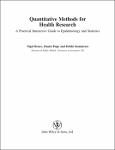Thông tin tài liệu
Thông tin siêu dữ liệu biểu ghi
| Trường DC | Giá trị | Ngôn ngữ |
|---|---|---|
| dc.contributor.author | Bruce, Nigel | - |
| dc.contributor.author | Pope, Daniel | - |
| dc.contributor.author | Stanistreet, Debbi | - |
| dc.date.accessioned | 2020-06-15T02:16:24Z | - |
| dc.date.available | 2020-06-15T02:16:24Z | - |
| dc.date.issued | 2008 | - |
| dc.identifier.uri | https://dlib.phenikaa-uni.edu.vn/handle/PNK/382 | - |
| dc.description.abstract | Welcome to Quantitative Methods for Health Research, a study programme designed to introduce you to the knowledge and skills required to make sense of published health research, and to begin designing and carrying out studies of your own. The book is based closely on materials developed and tested over almost ten years with the Master of Public Health (MPH) programme at the University of Liverpool, UK. A key theme of our approach to teaching and learning is to ensure a reasonable level of theoretical knowledge (as this helps to provide a solid basis to knowledge), while placing at least as much emphasis on the application of theory to practice (to demonstrate what actually happens when theoretical ‘ideals’ come up against reality). For these reasons, the learning materials have been designed around a number of published research studies and information sources that address a variety of topics from the UK, Europe and developing countries. The many aspects of study design and analysis illustrated by these studies provide examples which are used to help you understand the fundamental principles of good research, and to practise these techniques yourself. The MPH programme on which this book is based, consists of two postgraduate taught modules, one Introductory, the other Advanced, each of which requires 150 hours of study (including assessments), and provides 15 postgraduate credits (1 unit). As students and tutors using the book may find it convenient to follow a similar module-based approach, the content of chapters has been organised to make this as simple as possible. The table summarising the content of each chapter on pages xi to xiii indicates which sections (together with page numbers) relate to the introductory programme, and which to the advanced programme. The use of computer software for data analysis is a fundamental area of knowledge and skills for the application of epidemiological and statistical methods. A complementary study programme in data analysis using SPSS (Statistical Package for the Social Sciences) has been prepared; this relates closely to the structure and content of the book. Full details of this study programme, including the data sets used for data analysis exercises, are available on the companion web site for this book www.wileyeurope.com/college/bruce. The book also has a number of other features designed to enhance learning effectiveness, summarised in the following sections. | vi |
| dc.language.iso | en | vi |
| dc.publisher | John Wiley & Sons, Ltd | vi |
| dc.subject | Nursing | vi |
| dc.title | Quantitative methods for health research : A practical interative guide to epidemiology and statistics | vi |
| dc.type | Book | vi |
| Bộ sưu tập | ||
| BST Điều dưỡng | ||
Danh sách tệp tin đính kèm:

